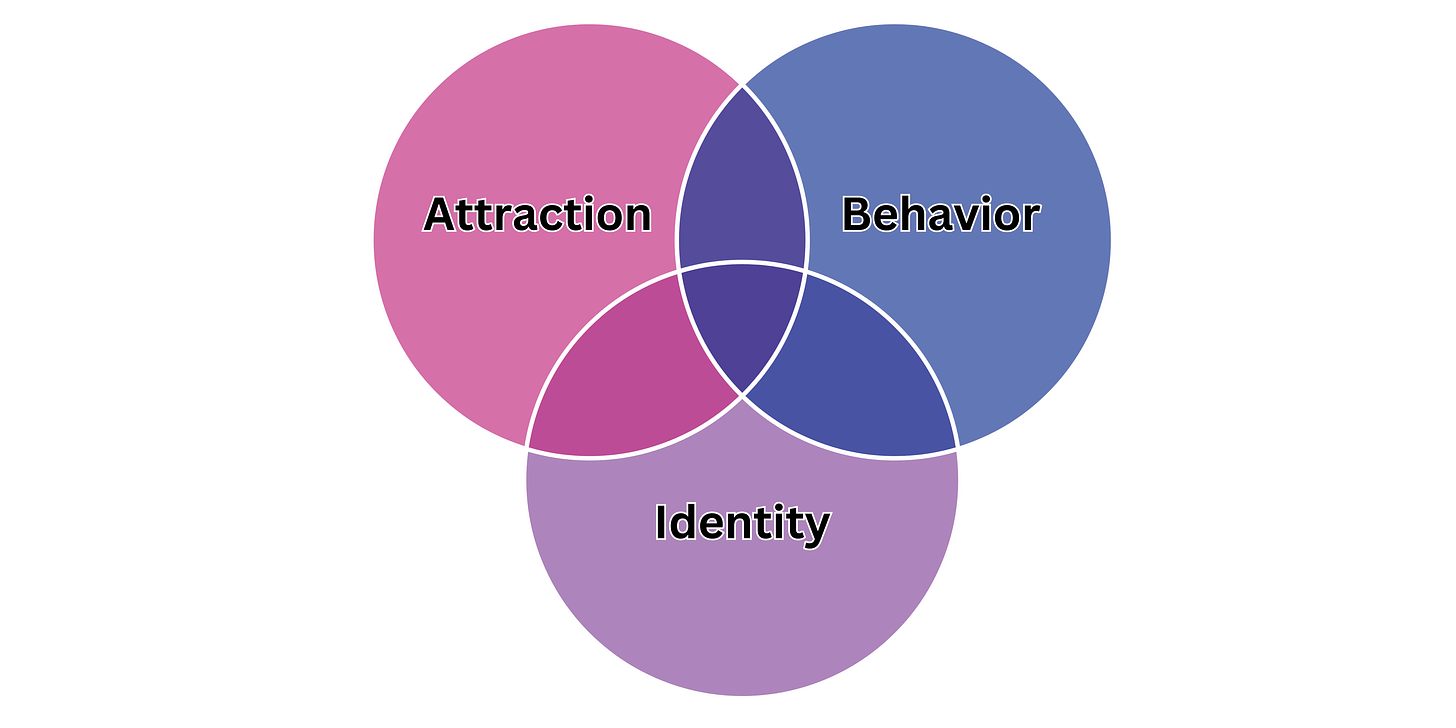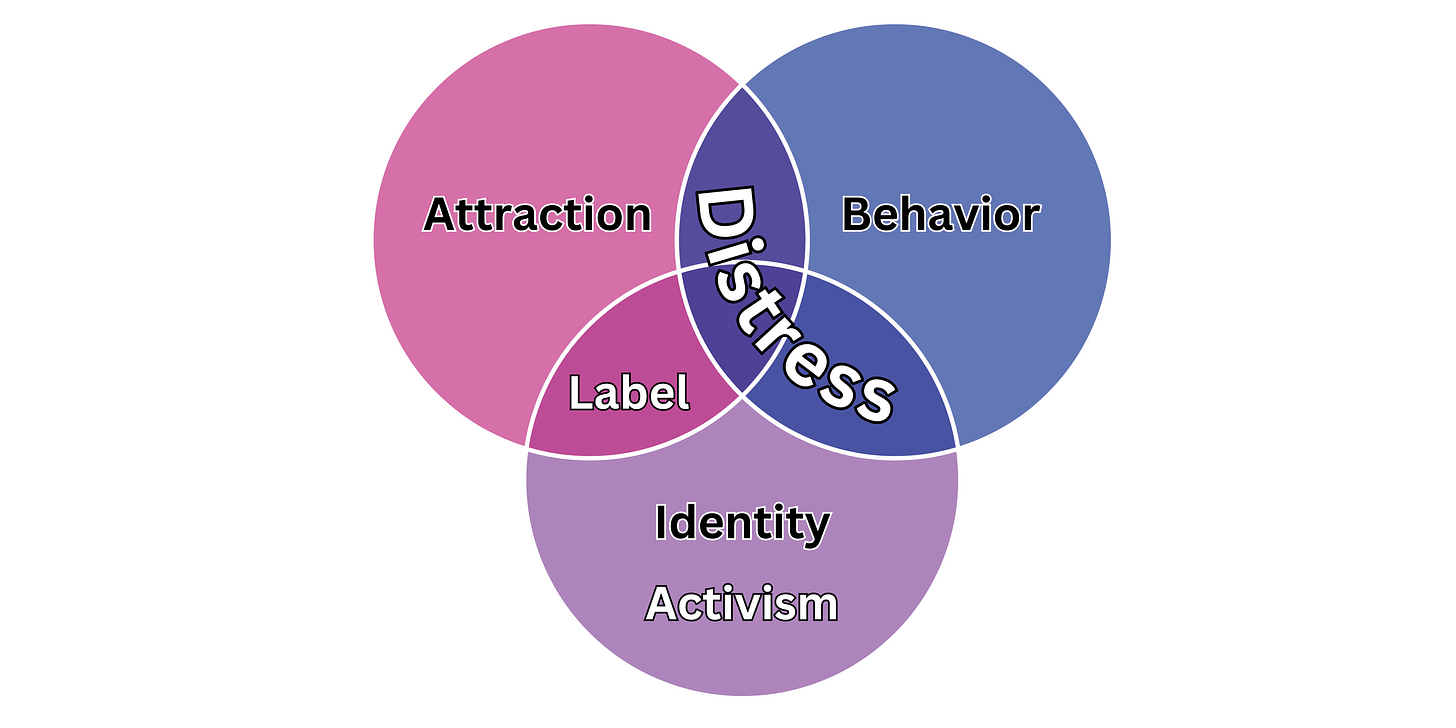“But my actions don’t define me”
Reflections on adopting a sexual identity.
As most of you have heard on the podcast, this is the first semester of a PhD program, and while I have many thoughts on many things, as I keep writing and researching about bisexuality, I keep coming full circle just to ask, “Okay, but what even IS sexual identity?”
Like many of you, this question didn’t first pop up for me in school. In fact, a large reason I started researching sexuality was because I didn’t know exactly what it was supposed to be. Now, as I compile a literature review of how bisexuality has been defined over the years, I ask again - what exactly even IS sexual identity?
Humans are multifaceted; we contain multitudes, and often, those multitudes contradict each other and how we live our lives. For those of us who obsess over the meaning of words, this gets… complicated. We come up with new terms to ensure these truths are still very much in line with one another, or at the very least, not openly contradict each other.
Often, the primary reference to try to solve these paradoxical experiences is the Split Attraction Model (SAM). This model splits sexual attraction from romantic attraction, allowing you to choose which one feels closer to your experience. In a way, it resembles an assembly line with “pick three”: one gender, one sexuality, one romantic attraction.
At first glance, this feels helpful. Having language to talk about conflicting feelings is necessary, right? However, the split attraction model has been criticized widely for a number of reasons, especially because it divides us further. It not only splits “attraction,” it splits the community. By interpreting early experiences as a kind of sexual with a kind of romantic, there is a lot of space for internalized homo/biphobia not only to flourish but become cemented in the self. Having these discrete labels and using them injudiciously can lead to a perpetuation of purity culture and a lack of space to explore and re-conceptualize the self beyond monosexual restrictions.
[Insert a story here about how someone just recently discovering same-gender attraction feels outside pressure from society to choose heterosexuality and live a “normal” life. They engage in a number of thought experiments, asking themselves that even if they could have sex with someone of the same gender, would they ever choose to live a life with them? They feel conflicted because they’ve never seen a positive representation of this in their entire life, so they come to a very satisfying conclusion: they are “bisexual, hetero-romantic.” Because they have a surface-level understanding of what that means, they do not know how to engage with resources that address internalized homo/biphobia and so go about their life, never knowing if they even could have had a same-gender romantic relationship.]
Because of the space for homo/trans/biphobia that the Split Attraction Model allows and refuses to challenge, it’s scarcely used in literature. The model that has gained the most traction is the Attraction, Identity, and Behavior Model (AIB) that kinda looks like this:
Here’s what’s really cool about the AIB model - you can be incredibly explicit about which intersection you find yourself in and distinguish it from other intersections in the model. For most folks, the label we choose for ourselves exists at the intersection of attraction and identity. We’ll say things like, “I’m bisexual because I experience attraction for genders like mine and unlike mine.”
The source of most distress for folks, I have found, is all the intersections with behavior. Here, we’ll often say things like, “I mean, I feel attraction for all genders, but I’ve only ever been involved with men - what’s my label?” or “I only see myself in a long-term relationship with a woman, but I think I’m open to dating anyone depending on the vibe - what does that mean?”
And the space where we find the biggest amount of activism and push for change sits squarely in the identity space. Regardless of our behavior or attraction at any specific moment in time, we all unite under a single identity to advocate for the recognition of all our rights. We understand ourselves as part of a group because there is strength in numbers and conviction in history.
Of course, because there is significant distress that bubbles up when our behavior does not “align” with our sexual identity or attraction, there is an immediate tension that begs to be solved. How can I begin to make sense of myself when my behavior appears to be at odds with who I think I am? This is where the Split Attraction Model becomes really tempting and promises us a full reconciliation with all three aspects of the AIB model. But the truth is, very rarely does anyone ever really find themselves in perfect alignment with their attraction, identity, and behavior.
So many factors influence the trajectory our lives take, even more so when it comes to relationships and intimacy. Our geographic location, social location, access to resources and community, and ability to self-regulate are just a few factors that can influence where we find ourselves within AIB. But here’s the most important of this model: it embraces complexity, liminality, and fluidity. There are tensions to experience at any of the overlaps, and you are strongly encouraged to embrace these tensions with compassion and explore what they mean for you.
We are all allowed to conceive of ourselves to the best of our language and ability. However, when it comes to community labels — when it comes to the way we speak about each other to each other, we must all concede to some discomfort to achieve greater equity. This is what has allowed every successful social movement to be a successful social movement.
The fight for bi+ness stems from an inherent recognition of the variety in experience and embodiment that comes with being such a diverse group in the first place. On the podcast, we make a point of using bisexual/plurisexual/bi+ as a way to ground ourselves in the historicity and pertinence of bisexual activism. This was a term that was applied to us pathologically, that we have reclaimed through years of hard work that too often has gone erased from the archives.
As bi+ scholars and activists, we recognize the profound diversity of experience within bi+ communities. We choose to fight for every single individual concern and struggle that bi+ people bring to the table because we count on the strength we have together. We must center our energies where they are needed most: against those who will pit us against each other for sheer personal gain.
And hey, if we’re able to normalize sex in the process – all the better.
With love & spite,
Jace
Was there something that resonated with you about this post?
Have question or situation you could use advice on?
Share your story with us to be featured in a future Give It to Me Bi entry!




